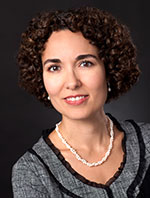Building a Better World
Adhamina Rodriguez (MPM '99) is CEO of AR Green Consulting, where she helps her clients become more strategically sustainable in their building design and construction.
By Adhamina Rodriguez (MPM '99)
I was raised in a town in the south of Spain with severe droughts and frequent blackouts, so from a very young age I developed a strong awareness of our planet’s limited resources.
 I went on to pursue my architectural degree in Spain, and it was there where I furthered my interest in green buildings and became a researcher for the Spanish Environmental Council. Then, in 1998, I traveled to Evanston to pursue my Master of Project Management (MPM) at Northwestern Engineering. Everything about the program appealed to me: The depth and flexibility of the curriculum, the outstanding faculty, the robustness of the alumni network, the job market opportunities, the wonderful university. Really, what’s not to like?
I went on to pursue my architectural degree in Spain, and it was there where I furthered my interest in green buildings and became a researcher for the Spanish Environmental Council. Then, in 1998, I traveled to Evanston to pursue my Master of Project Management (MPM) at Northwestern Engineering. Everything about the program appealed to me: The depth and flexibility of the curriculum, the outstanding faculty, the robustness of the alumni network, the job market opportunities, the wonderful university. Really, what’s not to like?
As I look back 20 years later, my time in the MPM program made me who I am today. I learned not only about engineering, construction management and financing, but also about other cultures and about myself. The MPM degree opened job opportunities that I had never imagined, and I built my professional career on the solid foundation set by the program.
I spent almost 17 years as Project Manager and Director of Sustainability for a large general contractor in San Francisco, but although we worked on some extraordinary green projects, we also spent a lot of time on projects that were not environmentally friendly. In 2015, I made the decision to focus on sustainability full time and founded AR Green Consulting. Today I serve as CEO of the firm, and I strive to improve the world one building at a time.
I think the public underestimates the impact buildings have on climate change and on human health. Ninety-one percent of greenhouse gas emissions come from burning fossil fuels, and that is usually visualized with a big coal-burning power plant. Did you know, though, that we are burning fossil fuels in our buildings, on-site, every day, by installing diesel generators and employing gas versus electricity to cook or heat water?
Buildings can and must be designed, built, and operated with a negative carbon footprint, which means that they should remove more carbon dioxide from the atmosphere than they release. We need to break free from fossil fuels by designing all-electric buildings, specify building materials that permanently sequester carbon, and energize our buildings with renewable sources. This type of sustainability leads to efficiency, flexibility, resiliency, and better wellbeing for us all.
It is up to us in this industry and this country to begin to reverse the global warming trend. I discovered how I can help do that at Northwestern, and for that, I am forever grateful. My advisor, Professor Krizek, was an invaluable help, and he helped me channel my interests and tailor the MPM curriculum to fit my needs. Twenty years later, he and I still keep in touch.
Looking back on my career, there is a lot that I am proud of, but my biggest accomplishment and pride are my three children who, on their own initiative, founded a Nature Club in primary school to raise awareness of environmental issues among fellow students and teachers. Whenever I emphasize sustainability, I do it with them in mind.

